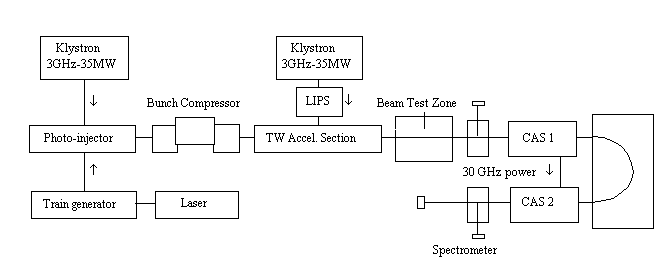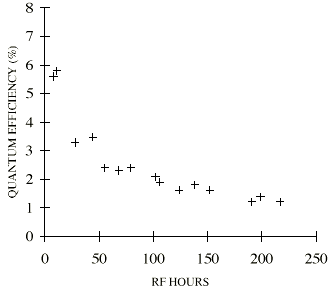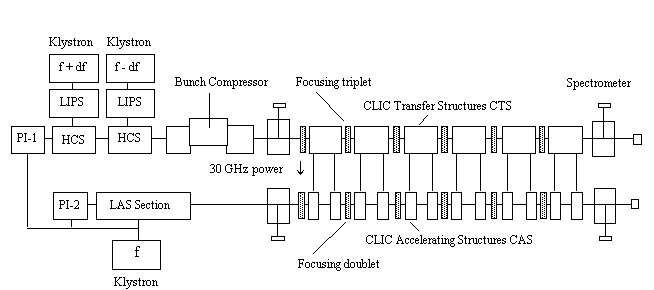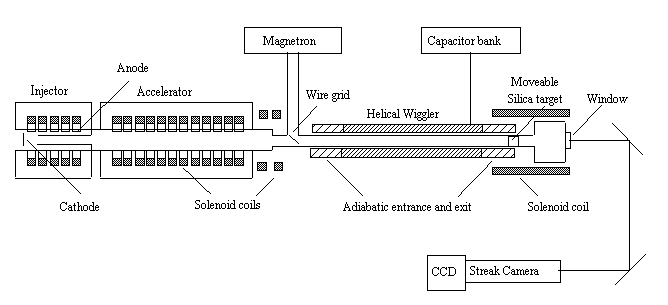CERN is studying the feasibility of building a 1
TeV c.m. e+e- linear collider (CLIC) based on 30 GHz accelerating
structures and RF power production from a low energy, high intensity
drive linac. Two major challenges of the CLIC two-beam scheme
are the generation of the high intensity drive beam and the extraction
of 30 GHz RF power using transfer structures. Two test facilities
are currently being used to study these specific problems. The
CLIC Test Facility (CTF) is a purpose-built CERN facility to study
the generation of the drive beam by photo-injectors, the generation
of 30 GHz RF power, and the testing of components. This facility
has produced single bunch charges of 35 nC with a bunch length
of 14 ps (FWHH) and up to 76 MW of 30 GHz RF power. It is at present
being updated to a 10 m long two-beam test accelerator producing
480 MW of 30 GHz RF peak power and accelerating electron bunches
with gradients of 80 MV/m. The FEL Test Facility at CESTA
(Bordeaux) is being used to study the generation of the CLIC drive
beam by direct bunching at 30 GHz. This facility has recently
made the first direct observation of beam bunching by a high power
microwave FEL. The status of these two test facilities and the
results obtained are given.
CERN is studying the feasibility of building a compact
1 TeV c.m. e+e-
linear collider based on normal conducting travelling wave accelerating
structures operating at 30 GHz and a gradient of 80 MV/m, and
RF power production from a low energy (3 GeV) high intensity drive
linac [1]. The design luminosity of 1034
cm-2s-1
is obtained by colliding 30 bunch pairs per RF pulse. With a bunch
spacing of 1 ns this means an RF pulse length of about 45 ns.
Typical peak powers of 150 MW/m are required along
each of the 6.25 km long main linacs. The two-beam scheme avoids
the thousands of individual klystrons, modulators and RF compression
units required by the classical approach. There are no active
RF components in either of the linacs resulting in a particularly
simple tunnel layout.
Generation of the drive beam and extraction of 30 GHz RF power from the drive beam using transfer structures is one of the major technological challenges of the CLIC two-beam scheme. The drive beam consists of trains of 30 bunchlets (spaced at 1 cm) with 50 nC/bunch and a s = 0.6 mm. It is proposed to generate this beam either directly using the bunching capability of an FEL or by combining the outputs of a battery of photoinjector linacs. The bunch trains are accelerated to 3 GeV using a 250 MHz superconducting linac. In the drive linac the bunched beam is progressively decelerated in transfer structures as RF power is supplied to the main linac.
An alternative scheme based on an isochronous storage
ring is also under study. This would also require a photo-injector
source and the beam would be accelerated by a 1.5 GHz SC
linac.
Two test facilities are currently being used to study the above-mentioned technological challenges of the CLIC scheme.
(i) The CLIC Test Facility (CTF) is a purpose-built CERN facility to study the generation of the drive beam by photo-injectors, the generation of 30 GHz RF power, and to test components.
(ii) The FEL Test Facility at CESTA (Bordeaux) is
being used to study the generation of the CLIC drive beam by direct
bunching at 30 GHz.
The CTF1 layout (CTF 1995) is shown in Fig.1.

CTF1 was built to (i) study the production of short,
high charge electron bunches from laser illuminated photocathodes
in RF guns, (ii) generate high power 30 GHz RF pulses by passing
bunch trains through transfer cavities for testing CLIC prototype
components, (iii) test beam position monitors.
The CTF1 electron source consists of a laser-driven
S-band photoinjector producing single bunches or trains of up
to 48 bunches with a spacing of 10 cm and a momentum of 12 MeV/c.
Introducing a correlated longitudinal energy spread by adjusting
the RF phase of the photo-injector and passing the bunches through
the magnetic chicane produces a longitudinal bunch compression
[2]. Final acceleration to 65 MeV/c is obtained using a 1 m long
S-band travelling wave (TW) section (NAS). A 1.5 m long drift
space between the TW section and a magnetic spectrometer is reserved
for testing CLIC prototype components with beam. Energy is extracted
from the beam by a 30 cm long TW section (CAS1) to provide short
high power 30 GHz RF pulses. This power is then used to feed either
a second identical CLIC structure (CAS2) or used to supply power
to other CLIC prototype components. The decelerated beam then
either goes to a dump, or is turned through 180 by bending magnets
at the end of the line and is re-accelerated by the second high
gradient CAS2 section. The facility is operated at a repetition
rate of 10 Hz.
Photo-injector
The photo-injector consists of a 1 -cell S-band RF
gun followed by a 4-cell SW booster cavity [3]. A Cs2Te photocathode
in the first 1/2 cell of the gun produces the electrons when illuminated
by 262 nm wavelength light (fourth harmonic of the Nd:YLF laser).
Multiple bunches are made by splitting the laser pulse into a
train of pulses each spaced by one 3 GHz wavelength. A maximum
laser energy before splitting of 1.0 mJ per pulse is available.
The laser pulse length is 8 ps FWHH. The RF gun is routinely operated
with a peak cathode field of 110 MV/m.
Photocathodes
The Cs2Te photocathodes are prepared in a laboratory [4] and are transported under vacuum and installed into the gun using a specially designed transfer system. The initial quantum efficiency (QE) is more than 10%. It however drops rapidly over the first 30 hours of operation and then stays at a level of about 2% for several weeks (see Fig. 2). The photocathode only deteriorates when the RF is on.
A GaAs cathode, prepared by SLAC, was tested up to
85 MV/m in the RF gun to test its high voltage holding capability.
This result is an important step in the study of the production
of polarised electrons using RF guns.

Electron bunches
A maximum single bunch charge of 35 nC has been obtained
from the gun-booster with a laser spot of about 10mm diameter.
The length and emittances of the electron bunches are measured
with a streak camera using the light pulse produced by the interaction
of the bunch with a transition radiation monitor or a Cerenkov
monitor. After the gun-booster cavity the bunch length is typically
10 ps (FWHH) with a charge of 10 nC. The bunch compressor is used
to reduce the length of single bunches by a factor of two to four
depending on the charge, the minimum measured was 3 ps FWHH. At
low charge per bunch transverse normalised emittances of about
30 mm.mrad are observed. With high charge per bunch both the transverse
emittance and the bunch length are blown up by space charge effects
at low energy. The maximum charges measured at various positions
along the beam line in both single and multibunch operation are
given in Table 1.
Table 1: Maximum measured charge in CTF1
|
| |
| Exit photo-injector | ||
| Exit TW section | ||
| Exit CAS1 |
In the photo-injector the single bunch charge is
limited by space charge forces whereas in multibunch operation
the maximum charge is limited by the available laser energy. In
the 3 GHz TW section, the beam loading limits the multibunch charge.
Beam is lost at the 4 mm diameter aperture restriction in CAS1
at high charges due to emittance growth caused by space charge
forces, transverse wakefields and chromatic errors in focusing
quadrupoles due to beam loading.
30 GHz Power generation
Significant amounts (>>1 MW) of 30 GHz power
can only be extracted from the CAS1 section by using bunch trains.
Peak power pulses 27 ns long of 76 MW with a 3 dB bandwidth of
12 ns have been generated using trains of 48 bunches with a charge
per bunch of 3 nC. This power level corresponds to a decelerating
field in the CAS1 section of 124 MV/m. In spite of these very
high fields, which are well above the CLIC nominal accelerating
gradient of 80 MV/m, no sign of RF breakdown or the need to condition
has ever been observed. The accelerating field in the second CLIC
CAS2 structure is determined from the difference between the maximum
energy gain and energy loss of the beam as its phase with respect
to the beam-induced RF accelerating field is varied. The highest
average re-accelerating gradient obtained in this structure was
94 MV/m.
30 GHz Power tests
One of the principle uses of the CTF1 has been the testing of CLIC prototype components using either a bunched beam directly or using 30 GHz pulsed power.
The following components were tested with 27 ns 60 MW power pulses: (i) 10 cm section of flexible WR28 waveguide (ii) high power stainless steel waveguide load, (iii) WR28 phase shifter, (iv) high gradient test section consisting of a sharp stainless steel point in a piece of standard WR28 waveguide (the aim of this test was to provoke a breakdown to examine breakdown behaviour).
No evidence of RF breakdown was observed in any of
these tests. High frequencies combined with short pulse lengths
are apparently very forgiving.
Testing 30 GHz components with beam
The following components were tested with beam.
(i) A 30 GHz transfer structure with two output waveguide channels. The measurements revealed unacceptable field inhomogeneities which subsequent simulations indicated would create serious transverse blow-up and energy dispersion effects.
(ii) A 30 GHz transfer structure with four output waveguide channels. Going to four channels substantially improved the field homogeneity.
(iii) A 30 GHz BPM system. The set-up consisted of two resonant E11 cavity BPMs to reduce beam jitter effects. A super-heterodyne receiver was used in the signal processing electronics to obtain charge independent horizontal and vertical positions in each BPM. Independent 0.1 µm resolution micromovers were used for displacement calibration. An upper limit on BPM resolution of ±4 µm was demonstrated [5], the measurement being limited by shot to shot angular jitter of the CTF1 beam.
(iv) Two large aperture button type 4 GHz bandwidth
BPMs for the CLIC drive beam with associated signal processing
system. A resolution of 0.2 mm was demonstrated.
Coherent radiation monitor test
Bunch length measurements were made for the TESLA
team using a coherent radiation monitor that they are investigating
[6]. A clear signal increasing as the square of the charge - the
coherent radiation signature - was obtained. It was demonstrated
that the device could be used to optimise the bunch compressor
setting.
CTF1 has achieved all its objectives and has clearly
demonstrated the principle of the two-beam acceleration scheme.
It will be upgraded in stages during the period 1996-1998 to a
two-beam test linac (the so-called CTF2) with the following main
goals [7].
(i) To study the feasibility of the two-beam acceleration on a larger scale than CTF1 with beam parameters as close as possible to those proposed for CLIC.
(ii) To design and construct a fully-engineered representative active-aligned test section of the 30 GHz drive and main linacs using nominal CLIC components working at nominal RF powers and accelerating fields.
(iii) To develop drive beam generation technology.
(iv) To compare measurements and CLIC beam dynamics simulations.
(v) To help estimate the realistic cost of a representative
part of the CLIC complex.
The proposed layout of CTF2 is shown in Fig.3.

Drive linac
The drive beam train (48 bunches spaced at 10 cm)
of 640 nC total charge is generated by the new S-band 2 -cell
RF gun [8] equipped with a Cs2Te photocathode and driven by the
same CTF1 laser. It is accelerated to 62 MeV/c by two new 0.65
m long high charge, high gradient (60 MV/m) TW structures (HCS)
built for CTF2 by LAL (Orsay) [9]. These structures, designed
to minimise both beam loading and transverse wakefield effects,
work at two slightly different frequencies (2998.55±7.81
MHz) to provide beam loading compensation to reduce the energy
spread along the train. After passing through a magnetic bunch
compressor, the bunch train is used to drive six CLIC transfer
structures (CTS). A transfer structure consists of a 15 mm diameter
beam tube coupled through four diametrically-opposite slots to
four periodically-loaded rectangular waveguides. Each 70 cm
long CTS provides enough power to drive two CLIC accelerating
sections (CAS) with 40 MW, 12 ns long, 30 GHz power pulses.
In a first stage when the drive beam charge is not yet at the
nominal value of 640 nC one CTS will be used to power one CAS.
In this configuration 453 nC are required to produce 40 MW at
the CAS input.
Main linac
The probe beam will consist of two bunches only.
The first bunch will have the CLIC nominal charge of 1.3 nC. The
second weaker bunch of 0.1 nC will possibly be used to probe the
wakefields induced by the first. The two bunches will be generated
by the existing 1.5-cell CTF RF gun and laser and will be accelerated
with the existing LAS section to 40 MeV before entering the string
of 30 GHz high gradient (80 MV/m) CLIC accelerating sections.
Most of these sections will be the constant impedance type but
damped structures will be added if and when they become available.
Active alignment system
In order to minimise problems due to misalignments
and at the same time to simulate the CLIC tunnel configuration
as closely as possible, both 30 GHz linacs will be equipped with
the support and active pre-alignment system developed for CLIC
in the Alignment Test Facility. The RF structures and all beamline
components are supported by precision v-blocks on 1.4 m long silicon
carbide box-section girders. The ends of two adjacent girders
are connected via link rods to a common platform that ensures
continuity of transverse position whilst permitting full rotational
freedom. The platforms are activated by three 0.1 µm resolution
stepping-motors (two in the vertical plane for vertical displacement
and axial rotation, and one in the horizontal plane). The triplet
focusing unit in the drive linac and the doublet unit in the main
linac are each supported and can be moved independently of the
beam lines by similar stepping motor drivers. An accurate active
alignment of the two linacs is obtained by referencing all moveable
elements to a stretched wire running along the length of each
linac by means of high precision capacitive position transducers.
The reference in the vertical plane is provided by an hydraulic
leveling system. The main linac will be equipped with a CLIC 30 GHz
BPM system and this could possibly be used at a later date for
beam-based active alignment tests.
Present status and future planning
The two 3 GHz linacs are complete except for the
two HCS sections which will be installed at the end of 1996. In
the meantime the 1 m long NAS section will be used. Two 30 GHz
modules will be installed for the end of 1996 and two more in
1997 and 1998. With all six modules installed the drive linac
will produce a total peak power of 480 MW and the main linac will
accelerate the probe beam to 320 MeV. In an ultimate stage,
in order to provide the capability to test elements above their
nominal field, the drive beam is expected to be increased to 1
C. A new 2 and 1/2-cell RF gun is at present being designed to
meet this requirement and is expected to become available in 1997.
With 1 C 217 MW would be produced at the TRS output and if used
to power a single CAS would generate an on-axis accelerating field
of 176 MV/m.
It was suggested some years ago that the CLIC drive beam could be generated directly with the required 1cm spacing by using the bunching properties of an FEL powered by an induction linac [10]. A collaboration to study this proposal was set up between CERN and the Centre d'Etudes Scientifiques et Techniques d'Aquitaine (CESTA) in Bordeaux. An experiment has been made using the 1kA 2.2 MeV induction linac LELIA as power source and has resulted in the first direct observation of bunching of a relativistic electron beam by a high power FEL interaction. The work reported here was carried out by the CESTA group [11] and more detailed information is given elsewhere in this conference.
A schematic layout of the experiment is shown in Fig.4. The induction linac is composed of 10 injector cells and 12 accelerating cells. Each cell is powered with a 100 kV 80 ns FWHH pulse. The 10 injector cells produce 1 MV at the thermionic cathode enabling 1 kA of beam to be extracted. The 1 MeV beam is then accelerated to 2.2 MeV by the 12 accelerating cells. Solenoidal magnets (1 kG maximum field) are used downstream of the cathode to focus the beam. Steering magnets are used to maximise transmission efficiency. The measured geometrical emittance at the end of the injector is 130 mm.mrad. A short two magnet transport section is used to transfer the beam from the exit of the linac (diameter 150 mm) to the entrance of the wiggler (diameter 40 mm). Half of the 1 kA beam is lost during this transfer process. The 2.88 m long wiggler magnet is formed from a double helix copper winding which is powered by a 10 kA 280 µs current pulse obtained by discharging a 50 kJ capacitor bank.

The wiggler produces a circularly polarised magnetic
field of up to 3 kG on its axis with a period of 12 cm. The first
six wiggler periods are strapped together to create an adiabatic
entry into the wiggler with a gradual increase in the transverse
momentum of the electrons, the same technique is used over four
periods at the exit. The FEL works in the amplifier mode, the
500 ns long input signal is provided by a 100 kW 35 GHz magnetron.
A tungsten wire grid is used to launch the wave into the circular
waveguide of the FEL interaction region. As a result of the electron
beam interaction with the EM wave in the field of the helical
wiggler the beam becomes bunched and the input power is amplified.
The extent of beam bunching is measured optically by analysing
the Cerenkov radiation produced by the beam hitting a 5 mm thick
silica target placed at different on axis positions at the exit
of the wiggler. The Cerenkov light is detected with a streak camera
and stored on a CCD camera. Viewing the light through a 0.3 mm
slit gives the distribution of the light intensity along the beam.

A typical scan showing a distinct bunch structure is shown in Fig.5 for a time interval of 278 ps at a position 27.5 cm from the wiggler exit. The bunch spacing corresponds to the FEL frequency. The 35 GHz modulated current component is about 150 A or approximately 30% of the total current. Inside the wiggler a vertical scan of the beam shows it to be bunched over its 5 mm diameter. At 80 cm from the wiggler exit the portion of the beam that displays bunching is reduced to a 0.5 mm spot. This reduction is due in part to longitudinal space charge forces but also depends on the magnitude of the solenoidal field used to extract the beam.
[1] H.Braun, R.Corsini, JP.Delahaye, G.Guignard, C.Johnson, J.Madsen, W.Schnell, L.Thorndahl, I.Wilson, W.Wuensch, B.Zotter, "CLIC - a compact and efficient high energy linear collider", CERN-SL-95-26, May, 1995.
[2] K.Aulenbacher, H.Braun, F.Chautard, R.Corsini, J.Madsen, L.Rinolfi, "Bunch compressor performances in the CLIC Test Facility", Proc. EPAC, Barcelona, June 1996, to be published.
[3] R.Bossart, J-C Godot, S.Lutgert, "Modular electron gun consisting of two rf sections and an intermediate focusing solenoid", Nucl. Instr. Meth., A340, p.157, 1994.
[4] G.Suberlucq, "Photocathodes pour le CLIC Test Facility du CERN", Proc. 7th Symposium on high current photo-emission, Grenoble, 1995.
[5] J.P.H.Sladen, I.Wilson, W.Wuensch, "CLIC Beam position monitor tests", Proc. EPAC, Barcelona, June 1996, to be published.
[6] K.Hanke, V.Schlott, K.Aulenbacher, H.Braun, F.Chautard, "Beam diagnostics using coherent transition at the CTF", CLIC Note 298, 1996.
[7] The CLIC Study Group, "CTF2 Design Report", CERN PS 96-14 (LP), July 1996.
[8] R.Bossart, H.Braun, M.Dehler, JC.Godot, "A 3 GHz photoelectron gun for high beam intensity", Proc. FEL Conference., New York 1995.
[9] G.Bienvenu, J.Gao, "A double high current, high gradient electron accelerating structure", Proc. EPAC, Barcelona, June 1996, to be published.
[10] H.D.Shay, R.Jong, R.Ryne, S.Yu, E.Scharlemann, "Use of a FEL as a buncher for a TBA scheme", Nucl. Instr. Meth, A304 (1991) 262-267.
[11] J.Gardelle, J.Labrouche, J.L.Rullier, Direct observation of beam bunching produced by a high power microwave free electron laser, Phys. Rev. Let., Vol.76, p.4532, June 1996.